Regional Employment Patterns in Scotland: Statistics from the Annual Population Survey, 2015
Summary publication of results from the Annual Population Survey 2015, presenting analysis on the labour market, education and training. Results are provided for Scotland and local authority areas in Scotland.
People in Work
Record high employment level seen in 2015, driven by the second highest women's employment level since comparable records began.
Employment levels (16+) in Scotland reached a record high 2,575,500 in 2015, driven by continued increases in the employment level for women, up 18,200 over the year to 1,255,100- the second highest level seen since comparable records began. (The highest occurred in Oct 2014-Sept 2015).
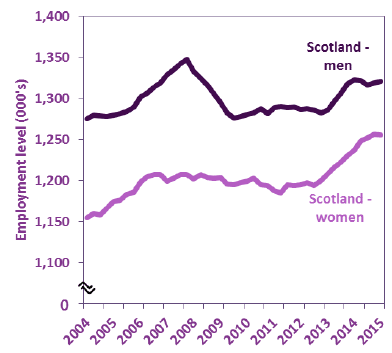
Employment levels for men dropped slightly to 1,320,400, down 1,500 over the year.
However, there are indications that the rapid growth seen through 2013 and 2014 is starting to level off.
Scotland's employment rate for women highest on record from APS, but overall employment rate still lags pre-recession high.
The employment rate for women in Scotland increased over the year to the highest seen on the APS (up 1.2 percentage points from 68.9% to 70.2%), driving the Scottish employment rate up 0.5 percentage points from 72.6% to 73.1%. The rate for men, however, was down 0.3 percentage points (from 76.4% to 76.2%).
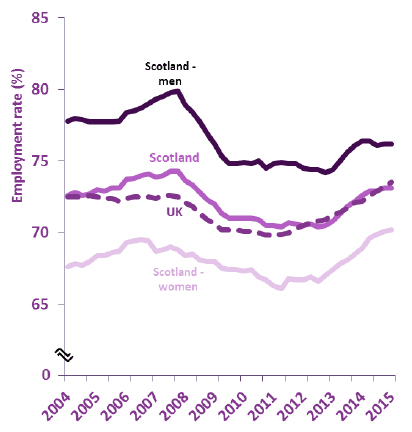
The employment rate for women is now higher than at the start of the recession (when it was 68.4%), while the rate for men, by comparison, is almost 4.0 percentage points lower than its Oct'07-Sep'08 record high of 79.9%.
Due to population growth and increases in employment for older workers, the headline employment rate is still lower than it was at the start of the recession.
Employment rate for men in Scotland not seeing the strong growth seen for men in UK over the year.
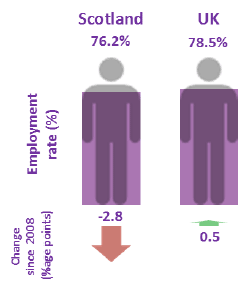
The employment rate in Scotland for men had increased between 2013 and 2014, after being generally flat or decreasing for several years. However, over the last year it decreased by 0.3 percentage points to 76.2%, and since the UK rate for males increased by 1.3 percentage points to 78.5% over the year, the gap with the UK has increased to 2.3 percentage points. The decrease in Scotland was driven by high reductions in employment levels in City of Edinburgh, Aberdeen City, West Lothian and North Ayrshire.
Employment rates for men in Scotland have yet to recover to their pre-recession high of 79.9% in Oct'07-Sep'08.
Employment rates for women increased to 70.2%, the highest since comparable records began.
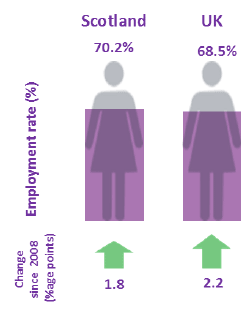
The employment rate for women in Scotland has been on a general upward trajectory since 2011. Over the year their rate increased by 1.2 percentage points to 70.2%, maintaining the gap with the rate for UK women at 1.6 percentage points as the UK rate increased by 1.1 percentage points to 68.5%. The increase in Scotland was driven by strong growth in employment levels in South Lanarkshire, Glasgow City, Highland and Aberdeen City.
The employment rate for women in 2015 was the highest on record from the APS, exceeding the rates seen at the start and prior to the 2008 recession.
The gender employment gap in Scotland was 6.0 percentage points, 4.0 percentage points lower than the UK and the lowest since comparable records began.
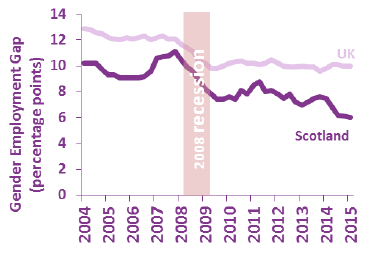
The gender employment gap in Scotland has reduced significantly from its peak of 11.1 percentage points in Oct'07-Sep'08 to 6.0 percentage points in Jan-Dec 2015.
During the 2008 recession the gap narrowed as the employment rate for men dropped faster and deeper than those for women and remained fairly static until 2013, when they started recovering.
By contrast, employment rates for women started recovering between 2011 and 2012, and have increased steadily since.
Employment rates increased in 19 local authority areas in Scotland over the year.
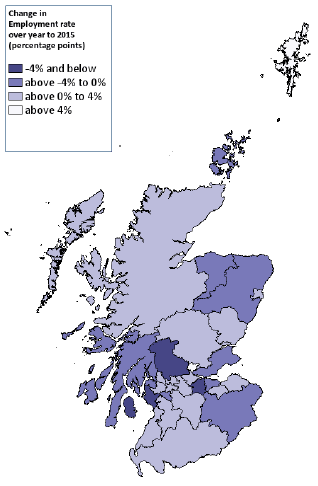
Employment rates vary considerably across local authority areas in Scotland. The change in employment rate over the year also varies as illustrated in the map [1] .
Over the year, employment rates increased in 19 local authorities, decreased in twelve and was unchanged in one, highlighting that the recovery is not being seen across all areas of Scotland. Statistically significant changes were seen in Dumfries & Galloway (up 3.7 percentage points), North Ayrshire (down 6.4 percentage points), Stirling (down 4.9 percentage points) and West Lothian (down 4.1 percentage points).
The 2015 APS data shows employment levels for men decreasing in Aberdeen, although this was offset by an increases in women's employment levels.
Fourteen local authorities have seen increases in their employment rate since 2008, but employment rates still remain lower than in 2008 in the remaining 18 local authorities.
Gap between employment rates of the top and bottom 3 performing local authorities in Scotland reduced by 1.4 percentage points over the year.
Over the year the gap between the employment rates of the the top and bottom three performing local authorities, as measured by the Cohesion Purpose Target, reduced from 17.8 to 16.4 percentage points due to employment rates in the bottom 3 performing regions increasing faster than the top 3. The gap is still wider than the 14.1 percentage points seen at the start of the recession .
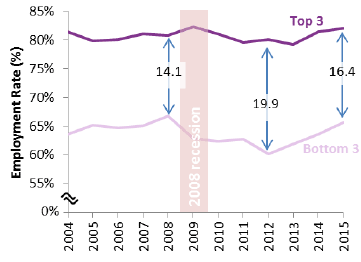
Further information about the Cohesion Purpose Target is available at
http://www.gov.scot/About/Performance/scotPerforms/purposetargets/cohesion
Gap between employment rates of disabled and non-disabled people was almost 40 percentage points.
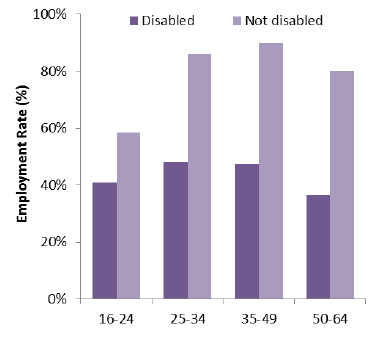
Employment rates for those classified as disabled under the Equality Act 2010 [2] were 38.3 percentage points lower than for those not classified as disabled.
Young (16-24) disabled people have the lowest employment rate gap across the age groups (17.7 percentage points), although they also have the lowest employment rate (40.8%). Older workers (50-64) have the largest gap (43.5 percentage points) reflecting greater health issues faced by those in this age group.
Disabled women in Scotland had a lower employment rate gap than disabled men in 2015 (34.8 and 41.9 percentage points respectively).
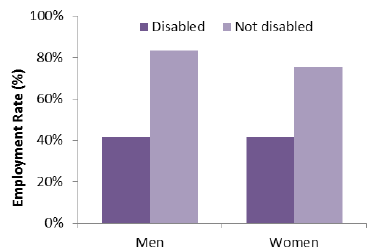
This will, in part be due to non-disabled women having a lower employment rate than non-disbaled men, but is mainly due to disabled women having an almost identical employment rate to disabled men, although it should be noted that employment rates for different health conditions vary substantially.
Minority ethnic women had substantially lower employment rates than ethnic white women.
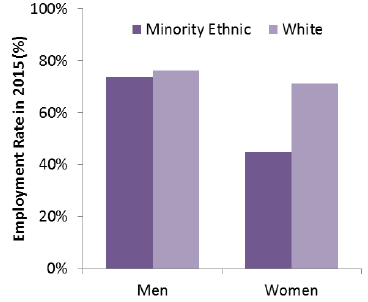
Employment rates for ethnic minorities in Scotland are on average [3] about 13 percentage points lower than those for the white population.
The difference is driven mainly by much lower employment rates for minority ethnic women which are typically below 50% (about 20 percentage points lower than white women). In contrast,the difference for minority ethnic men on average is around 7 percentage points (in 2015, the gap was slightly under 3 percentage points, but due to small sample sizes for the minority ethnic group in Scotland, these estimates are quite volatile).
Youth employment rates in Scotland have decreased by 4.5 percentage points since the recession but increased for those aged 50-64.
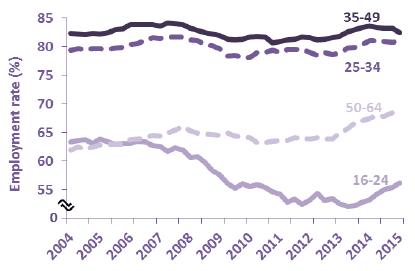
Employment rates for 25-34 and 35-49 year olds generally remained around 80% even through the recession, indicating a fairly high resilience to economic change.
Younger workers (16-24) saw the main impact of the recession, their rates reducing from 60.7% in 2008 to 53.2% in 2014 but recovering slightly to 56.2% in 2015. In contrast, employment rates for workers aged 50-64 have increased through the recovery.
Men driving decrease in employment rates for younger workers since 2008, while women drive increase for those aged 50-64.
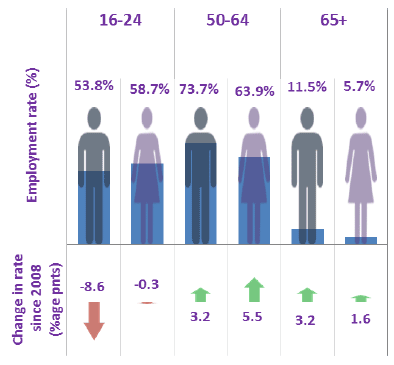
Younger men have seen a 8.6 percentage point decrease in their employment rate since 2008.
Younger workers have generally moved from employment and (to a lesser extent) unemployment into inactivity (mainly into further or higher education).
Employed women and (to a lesser extent) men aged 50-64 have seen an increase in their employment rates since 2008.
This is in part due to changes in the state retirement age for women, but there may also be other reasons including improved health of older workers and the need to supplement pension provisions.
Youth employment rates increased in 21 local authority areas over the year as overall youth employment rate in Scotland increased by 3.0 percentage points to 56.2%.
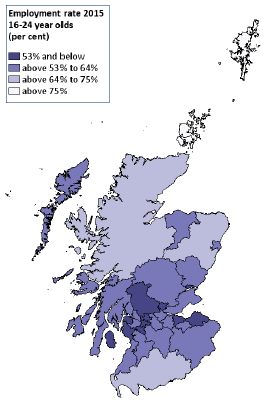
The youth employment rate in Scotland increased by 3.0 percentage points over the year to 56.2% in 2015, and increased by the same amount to 53.5% in the UK.
However, youth employment rates remain lower than in 2008 in both Scotland (4.5 percentage points lower) and the UK (2.4 percentage points lower).
Twenty-one local authorities [4] have seen increases in their youth employment rates over the year to 2015, while eleven local authorities have seen decreases over the same period.
Shetland Islands, Orkney Islands and Highland had the highest youth employment rates in 2015 (85.4%, 80.7% and 71.5% respectively).
Dundee City, North Ayrshire and Stirling, had the lowest youth employment rates in 2015 (43.0%, 44.2%, 45.7% respectively). Employment rates in Dundee City and Stirling will be affected by large student populations in these authority areas.
Number of workers aged 65 and over has almost doubled since 2004, helping drive higher employment rates for older workers.
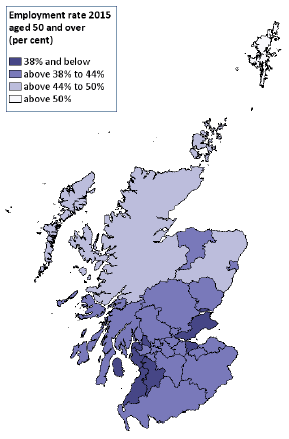
The employment rate for older workers (50+) in Scotland has been increasing steadily from 35.7% in 2004 to 39.8% in 2015, driven by:
- a 27.3% rise in employment level for 50-64 year olds (from 573,200 to 729,900), with their employment rate increasing from 61.9% to 68.6%.
- a 94% rise in employment level for those aged 65 and over (from 41,200 to 80,000), with their employment rate increasing from 5.2% to 8.2%.
Women accounted for almost 60% of the increase in those aged 50-64, whilst men accounted for around 60% of the increase in those aged 65+. The shift in both cases is mainly from inactivity to employment (delaying retirement or moving back into work from either retirement or sickness).
North/South split appears more marked for older workers' employment rates. The local authorities with the highest employment rates for older workers -Shetland Islands (55.5%), Orkney Islands (49.1%), Highland (48.3%), Na h-Eileanan Siar (46.6%), Aberdeenshire (45.4%) - all lie in the north of the country.
Over half of workers over state retirement age in Scotland said they had not retired yet because they are not ready to stop working.

In 2015, there were 92,400 workers in Scotland who were over state pension age.
The main reason given for remaining in work was that they were not ready to stop work yet [5] (57%).
13% had chosen to remain in work to pay for essential items (e.g. bills) while 8% had remained in work to boost their pension pot.
* - Other includes opportunity to work flexible hours, wanting to stay mentally/physically fit and a wide range of other personal reasons
Full-time employment levels for women increased to 727,500 - the highest level since comparable records began.
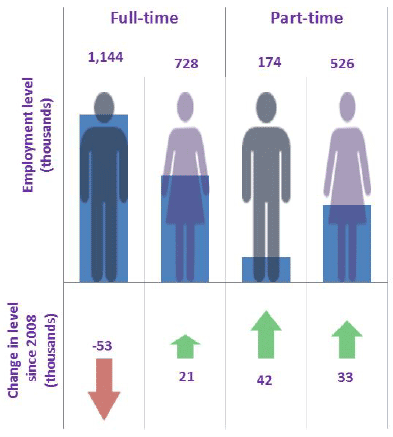
Full-time employment levels for women in Scotland rose by over 25,000 over the year to reach its highest levels seen on the APS at 727,500, while full-time employment levels for men reduced by 5,000 over the same period, partially offset by a 4,100 increase in part-time employment. Overall, full-time employment levels rose by 20,600 over the year while part-time employment levels decreased by 3,500, indicating a small shift into full-time work.
Full-time employment levels in 2015 (1,871,600) were still over 32,000 lower than in 2008 when they were 1,903,800, driven by a 53,100 decrease in full-time employment levels for men.
Both men and women have seen increases of over 30,000 in levels of part-time employment levels since 2008.
This indicates a shift from full to part-time employment for men, while the increase for women is mainly due to shifts from unemployment or inactivity.
Rise in underemployment driven mainly by increase for workers age 25-34 and men in full-time work.
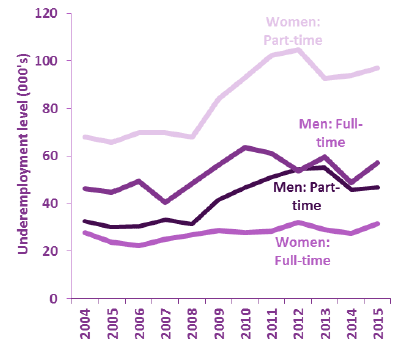
The underemployment [6] level in Scotland increased by 16,100 over the year to 232,700, with the rate increasing by 0.6 percentage points from 8.6% to 9.1%.
The increase in underemployment over the year was mainly driven by increases in levels for men in full-time work (up 8,400) although smaller increases were also seen for women in full-time work and both men and women in part-time work.
All age groups except 16-24 year olds saw increases over the year in underemployment, with 25-34 year olds seeing the largest increase (up 14,500).
Underemployment is still higher in most local authorities than it was prior at the start of the 2008 recession.
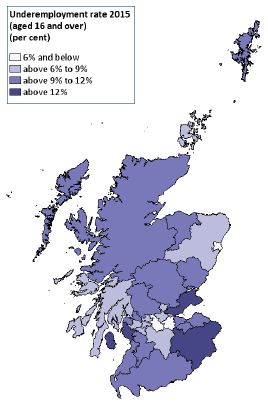
The local authority areas with the highest underemployment rartes in 2015 were North Ayrshire (13.6%), Scottish Borders (13.1%), Fife (12.6%), while the lowest rates were seen in West Lothian (5.0%), Aberdeen City (5.5%) and North Lanarkshire (5.9%).
Underemployment rates reduced in 15 local authority areas over the year, while 17 saw increases. Statistically significant increases were seen over the year in City of Edinburgh (up 4.0 percentage points from 6.0% to 10.0%) and South Lanarkshire (up 3.3 percentage points from 5.6% to 8.9%).
Underemployment remains higher in most local authority areas than in 2008, with 27 local authorities having a higher rate, 4 having a lower rate and 1 remaining unchanged. The highest statistically significant increases were seen in Scottish Borders and City of Edinburgh (up 5.8 and 5.4 percentage points respectively) while the largest statisitcally significant decreases were seen in North Lanarkshire and West Lothian (both down 1.2 percentage points).
Gender segregation remains a persistent issue across several industry sectors and occupational groups in Scotland.
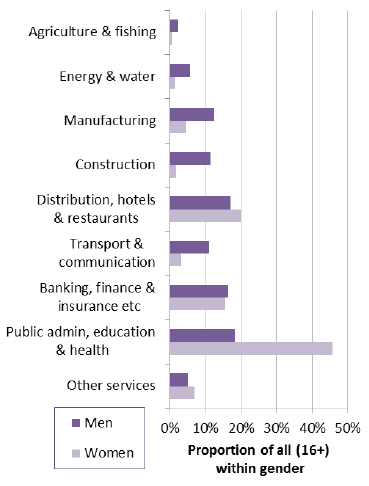
Although equality legislation has been in place for many years [7] gender segregation is still apparent in many industry sectors in Scotland.
Almost half of women in Scotland (45.7%) work in the Public admin education and health sector. (Note this is not the same as the Public Sector).
Over two-fifths (43.2%) of men work in sectors that exhibit high levels of gender segregation: Manufacturing (12.5%), Construction (11.4%), Transport and communication (11.1%), Energy and water (5.8%) and Agriculture and fishing (2.4%).
The general level of gender segregation within the most highly segregated industry sectors has not changed substantially since the APS started in 2004.
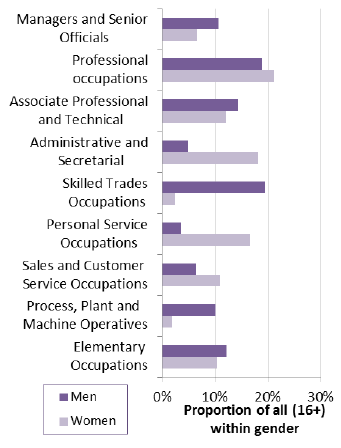
Gender segregation across the various occupational groups shows a similar picture to that seen across industry sectors. Specific occupational groups show high levels of segregation and these show little change over time.
Almost half of all women (45.7%) in Scotland were employed in occupations that are gender segregated towards women: Administrative and secretarial (18.2%), Personal service (16.6%) and Sales and customer service occupations (10.9%).
Almost a third (29.4%) of men in Scotland were employed in occupations that exhibit high levels of gender segregation: Skilled trades (19.3%) and Process, plant and machine operatives (10.1%).
Gains in employment levels seen over the year in Banking, finance and insurance and Public admin, education and health sectors.
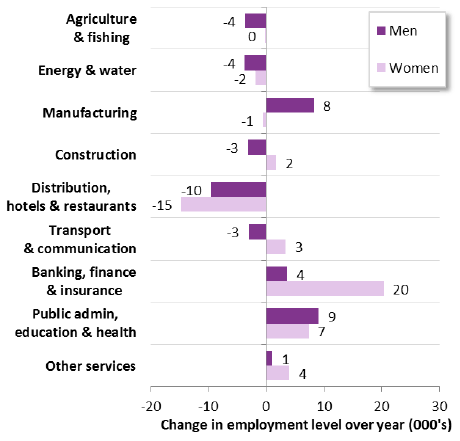
Over the year to 2015, the largest increases in employment levels were seen in the Banking, finance and insurance and the Public admin, education and health sectors (up 24,000 and 16,500 respectively).
The largest decrease in employment level was seen in the Distribution, hotels and restaurants sector (down 24,200).
The decrease seen in the Energy and water sector (down 5,600) may reflect lower oil prices. Over half the decrease in this sector was seen in Aberdeen City (down 3,300).
Private sector employment in 2015 was 1,876,500 - amongst the highest on record since the series began.
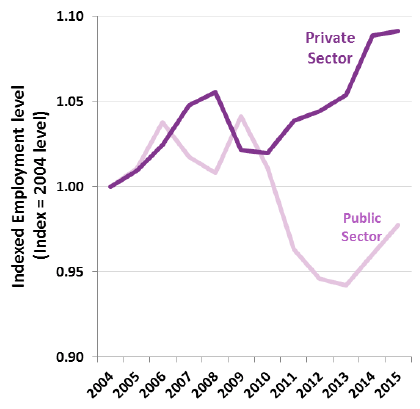
Since the series began in 2004, there have been increases in the number of those aged 25-34, 50-64 and 65+ employed in the private sector (up 75,100, 93,200 and 30,300 respectively) while the number of those aged 16-24 and 35-39 employed in the private sector has decreased (down 16,100 and 25,600 respectively).
Since 2008, the increases seen in private sector employment have been driven by increases in part-time employment (up 71,400), while full-time employment decreased by 10,500, although it has been recovering since 2013.
In contrast the decreases seen in the public sector [8] since 2008 were driven by decreases in full-time employment levels (down 23,000).
Impact of Education on employment prospects.
Skills are a key factor considered by employers. Having the right skills generally improves employment prospects for individuals although it is not the only consideration.
People with Further and Higher education qualifications have employment rates almost double that of those with qualifications Credit Standard grade and below.
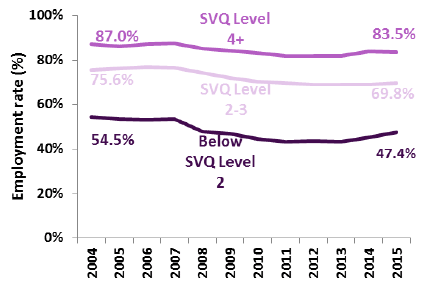
There is a strong link between educational attainment and employability.
The employment rate for those with SVQ level 4+ qualifications (83.5%) is almost double that for those with below SVQ level 2 qualifications (47.4%).
The difference between employment rates of those with SVQ level 4+ and SVQ level 2-3 qualifications is 13.7 percentage points.
A record high 48.4% of working people (aged 16-64) have Further or Higher education qualifications (or equivalent) in Scotland.
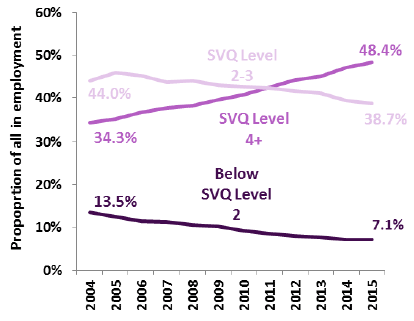
The increase in the proportion with SVQ level 4 or higher qualifications is being driven by the highest level of workers with Degree or Professional qualifications (792,000), up 33,300 since 2014 and the highest level of workers with HNC/HND level qualifications (414,700), up 5,700 over the year.
Those with SVQ level 4 or higher qualifications are the largest group in Scotland. In the UK, those with SVQ level 2 or 3 make up the largest group at 42.7%. The general trend towards higher level qualifications is however similar to that seen in Scotland.
Over a third (34.6%) of workers aged 25-64 in Scotland were graduates in 2015 - the highest on record from the APS.
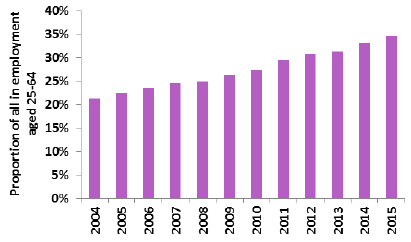
The proportion of 25-64 in Scotland who were graduates in 2015 was the highest seen since records began in 2004. This was driven by increases in 24 local authority areas over the year.
The largest increases were seen in South Ayrshire, Aberdeenshire and Argyll and Bute (all up 4.6 percentage points to 31.3%, 33.6% and 30.1%, respectively).
Contact
There is a problem
Thanks for your feedback